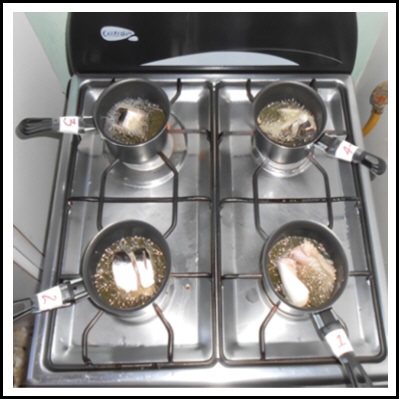Efecto del método de cocción sobre la concentración de metales pesados en Hoplias malabaricus (Erythrinidae)
Effect of cooking method on heavy metal concentrations in Hoplias malabaricus (Erythrinidae)
DOI:
https://doi.org/10.24054/bistua.v22i1.2534Keywords:
Ecotoxicology, fish, public health, wetlandsAbstract
Impacts of mining and agriculture have turned mercury (Hg), methylmercury (MeHg), zinc (Zn), cadmium (Cd), lead (Pb) and copper (Cu) into common pollutants in the fish and ecosystem compartments of Colombian wetlands. For this reason, in this study we evaluated concentrations of these metals in Hoplias malabaricus muscle, and determining their variations according 5 cooking methods (Smoked, Fried, Stew, Viuda and Salpicón). The concentrations were determined by thermal decomposition, amalgamation and atomic absorption spectroscopy (EPA-7473) (Hg-MeHg), atomic absorption spectroscopy with flame (FLAAS) (EPA-7000B) (Zn-Cu) and atomic absorption spectroscopy in graphite furnace (GFAAS) (EPA-7010) (Pb-Cd).We found Zn was the metal most accumulated in this tissue, likewise Cd (Fried, Viuda, Smoked and Salpicón) and Pb (Salpicón) exceeded maximum permissible limits (EU, 2018) and FAO (1992) for mean concentrations in fish muscle for human consumption. Similarly significant differences (p<0.05) in mean concentrations of Cd and Pb in muscle cooked with Smoked in Salpicón methods were determined respect to the rest. Risk indicators (DID, HQ and HI) for health assessment of the population by consumption of Hoplias malabaricus showed La Mojana habitants are exposed to high risk level, mainly due consumption of this species cooked with Salpicón method.
Downloads
References
J. Marrugo-Negrete, L. N. Benítez, J. Olivero-Verbel, E. Lans, and F. V. Gutierrez, “Spatial and seasonal mercury distribution in the Ayapel Marsh, Mojana region, Colombia,” International Journal of Environmental Health Research, vol. 20, no. 6. Informa UK Limited, pp. 451–459, Dec. 2010. doi: 10.1080/09603123.2010.499451.
J. Marrugo Negrete, J. Pinedo-Hernández, R. Paternina–Uribe, L. Quiroz-Aguas, and S. Pacheco-Florez, “Distribución espacial y evaluación de la contaminación ambiental por mercurio en la región de la Mojana, Colombia,” Revista MVZ Córdoba, vol. 23, no. S. Universidad de Cordoba, pp. 7062–7075, Nov. 20, 2018. doi: 10.21897/rmvz.1481.
M. A. Meza Martínez et al., “Mercurio total en hígado de Trachemys callirostris (Gray, 1856) (Testudines: Emydidae) en tres zonas de la Mojana, Sucre-Colombia,” Revista U.D.C.A Actualidad & Divulgación Científica, vol. 23, no. 1. Universidad de Ciencias Aplicadas Y Ambientales - UDCA, Apr. 14, 2020. doi: 10.31910/rudca.v23.n1.2020.1239.
A. J. Zabaleta et al., “Curve Number (CN) as Pressure Indicator of the Hydrological Condition under Global Warming Scenarios at a Local Scale in La Mojana Region, Colombia,” Indian Journal of Science and Technology, vol. 11, no. 29. Indian Society for Education and Environment, pp. 1–12, Aug. 01, 2018. doi: 10.17485/ijst/2018/v11i29/129276.
M. S. Rahman, N. Saha, A. H. Molla, and S. M. Al-Reza, “Assessment of Anthropogenic Influence on Heavy Metals Contamination in the Aquatic Ecosystem Components: Water, Sediment, and Fish,” Soil and Sediment Contamination: An International Journal, vol. 23, no. 4. Informa UK Limited, pp. 353–373, Dec. 16, 2013. doi: 10.1080/15320383.2014.829025.
P. Morcillo, M. Angeles Esteban, and A. Cuesta, “Mercury and its toxic effects on fish,” AIMS Environmental Science, vol. 4, no. 3. American Institute of Mathematical Sciences (AIMS), pp. 386–402, 2017. doi: 10.3934/environsci.2017.3.386.
N. K. McRae, S. Gaw, and C. N. Glover, “Mechanisms of zinc toxicity in the galaxiid fish, Galaxias maculatus,” Comparative Biochemistry and Physiology Part C: Toxicology & Pharmacology, vol. 179. Elsevier BV, pp. 184–190, Jan. 2016. doi: 10.1016/j.cbpc.2015.10.010.
L. Song, M. G. Vijver, W. J. G. M. Peijnenburg, T. S. Galloway, and C. R. Tyler, “A comparative analysis on the in vivo toxicity of copper nanoparticles in three species of freshwater fish,” Chemosphere, vol. 139. Elsevier BV, pp. 181–189, Nov. 2015. doi: 10.1016/j.chemosphere.2015.06.021.
D. M. Templeton and Y. Liu, “Multiple roles of cadmium in cell death and survival,” Chemico-Biological Interactions, vol. 188, no. 2. Elsevier BV, pp. 267–275, Nov. 2010. doi: 10.1016/j.cbi.2010.03.040.
F. Hameed Et Al., “Hazardous Effects of Cadmium Contaminated Water on Biological Characteristics of Fish; A Review,” RHAZES: Green and Applied Chemistry, p. Vol 6 (2019), Aug. 2019, doi: 10.48419/Imist.prsm/Rhazes-v6.17566.
A. Ishaque, S. Ishaque, A. Arif, and H. Abbas, “Toxic effects of lead on fish and human,” Biological and Clinical Sciences Research Journal, vol. 2020, no. 1. Medeye Publishers, Dec. 28, 2020. doi: 10.54112/bcsrj.v2020i1.47.
C. Galeano-Páez et al., “Dietary exposure to mercury and its relation to cytogenetic instability in populations from ‘La Mojana’ region, northern Colombia,” Chemosphere, vol. 265. Elsevier BV, p. 129066, Feb. 2021. doi: 10.1016/j.chemosphere.2020.129066.

Additional Files
Published
Versions
- 2024-06-21 (3)
- 2024-06-21 (2)
- 2023-12-20 (1)
Issue
Section
License
Copyright (c) 2023 © Autores; Licencia Universidad de Pamplona

This work is licensed under a Creative Commons Attribution-NonCommercial-NoDerivatives 4.0 International License.
© Autores; Licencia Universidad de Pamplona





